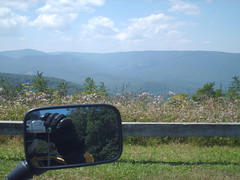When I bought my Seagull Performer CW Folk and even my Traveller Pro-Series - there is a warning in the owner's manual to not touch the truss rod unless you are professional luthier. Barely knowing what I was doing with the guitar I decided to leave it alone and just play the instruments as they came from the factory. The Traveller has always had a light action with a narrow neck and is easy to play for a beginner. The Seagull on the hand had beautiful tone but was harder to play with the wider neck and the higher action.
My friend Steve in Rochester was having similar problems with tone, sustain and action on his guitar. I forget the brand name but I know it's made in Indonesia. He decided to fix the problem last spring and adjust the guitar on his own. I don't think he adjusted the truss rod but I know he cut the bridge down to bring the action closer to the fretboard. The effect was dramatic and the instrument became much easier to play, had better sustain and feel. Although, I loved the effect I wasn't about to butcher my brand new Seagull to get achieve the same results.
After four months of ownership with the Seagull, I decided to look into adjusting my guitar but I wanted to do something better than just 'guessing' the procedure. I did several Internet searches and several searches on Amazon. I came up with a website form Guild guitars that shows you how to properly adjust your guitar. Some of the other sources I found had esoteric instructions like 'look down the fingerboard and see if it bows in or out...and adjust the truss rod until it looks even'. For me, that doesn't work - I don't know what I'm doing so how am I to know if it 'looks' right. That's almost back to guessing.
The Guild web site describes a method that uses accurate measurements that anyone with basic mechanical skills could follow. The tools are simple; a feeler gauge that you can get from an auto parts store, a fine ruler marked to 1/64 or 1/32 - my feeler gauge had this, an electronic tuner, the truss rod adjusting tool that came with your guitar - both of my guitars came with a truss rod tool, a capo, and either a file or a sanding block.
Follow the instructions at the Guild web site as described. The truss rod tool is either an allen wrench (aka hex key) or a nut driver. If your guitar does not have one - you might be able to search your tool box for a suitable allen wrench or nut driver or as a last resort, your local music store. To adjust the bridge - you may need to lower the bridge and this means removing some material from the bottom of the bridge. I needed to remove 2/32" from my bridge. I first marked one side of the bridge before removing so I know which way it goes back in - this is important. Then I took the bridge out to my garage and used one of those portable workbenches that have a vice in the middle. I put the bridge upside down in the vice loosely and adjusted the part sticking out of the vice to the amount I need to removed. I checked both ends before tightening. Then I used my electric circular sander to remove the 2/32" sticking out of the vice by sanding down to the vice. Hope that makes sense.
I reassembled my guitar - checked the tuning and then measured the nut. The nut didn't need any adjustment. I was solid. I rechecked all measurements to verify that I did everything correctly. Spot On! My guitar now sounds absolutely 100% better and is easier to play. There's not much you can really goof up if you take your time and work with the instructions and your guitar. Don't force anything and if you really feel this is outside of your comfort zone then pay to have this done - it's worth it.
Guild Acoustic Guitar Setup Guide.
Subscribe to:
Post Comments (Atom)







No comments:
Post a Comment